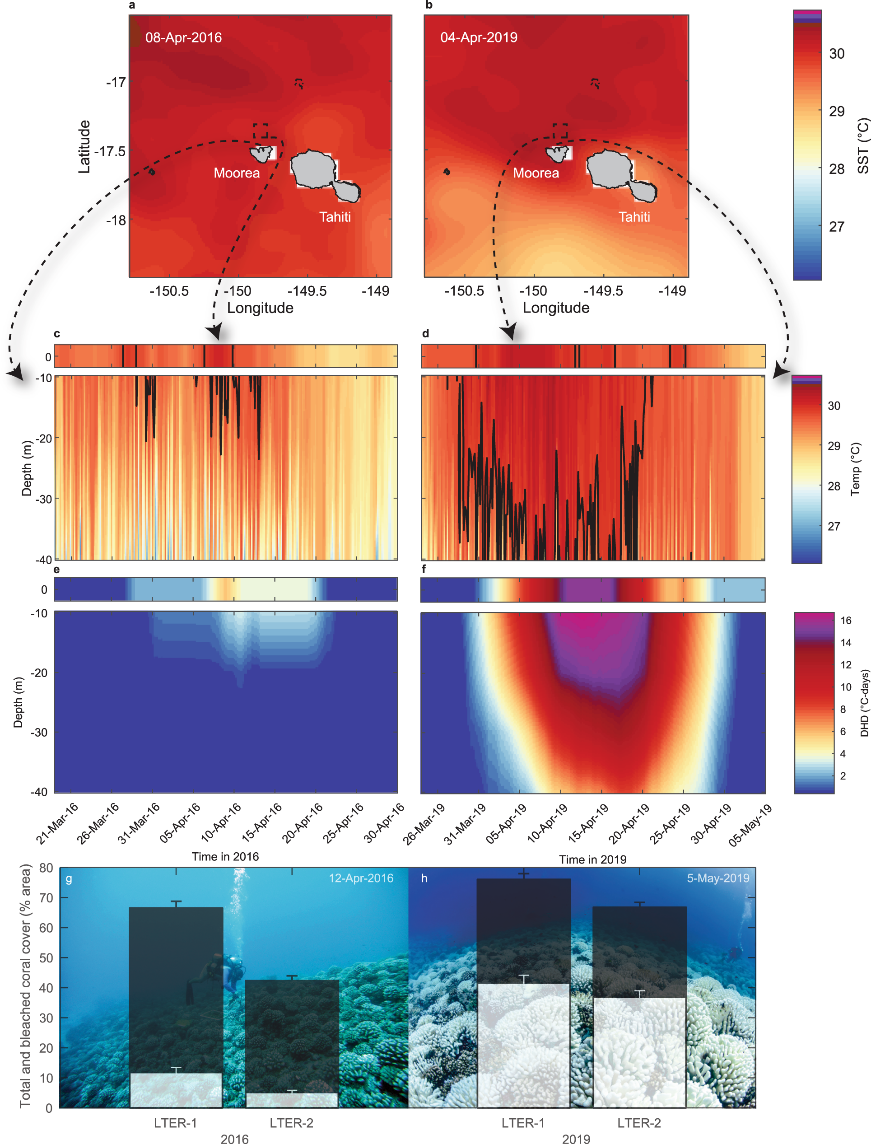隐藏的热浪和严重的珊瑚白化与中尺度涡旋和温跃层动力过程有关
Hidden heatwaves and severe coral bleaching linked to mesoscale eddies and thermocline dynamics
作者:Alex S. J. Wyatt, James J. Leichter, Libe Washburn, Li Kui, Peter J. Edmunds, Scott C. Burgess
期刊:Nature Communications
The severity of marine heatwaves (MHWs) that are increasingly impacting ocean ecosystems, including vulnerable coral reefs, has primarily been assessed using remotely sensed sea-surface temperatures (SSTs), without information relevant to heating across ecosystem depths. Here, using a rare combination of SST, high-resolution in-situ temperatures, and sea level anomalies observed over 15 years near Moorea, French Polynesia, we document subsurface MHWs that have been paradoxical in comparison to SST metrics and associated with unexpected coral bleaching across depths. Variations in the depth range and severity of MHWs was driven by mesoscale (10s to 100s of km) eddies that altered sea levels and thermocline depths and decreased (2007, 2017 and 2019) or increased (2012, 2015, 2016) internal-wave cooling. Pronounced eddy-induced reductions in internal waves during early 2019 contributed to a prolonged subsurface MHW and unexpectedly severe coral bleaching, with subsequent mortality offsetting almost a decade of coral recovery. Variability in mesoscale eddy fields, and thus thermocline depths, is expected to increase with climate change, which, along with strengthening and deepening stratification, could increase the occurrence of subsurface MHWs over ecosystems historically insulated from surface ocean heating by the cooling effects of internal waves.

Fig. 1 Satellite sea-surface temperatures (SSTs in °C) varied little regionally between a 2016 and b 2019 MHWs (see Fig. 2 for regional SST patterns), peaking at 30.1 °C on 8 April 2016 compared to 30.2 °C on 4 April 2019, but were locally elevated north of Moorea for longer during 2019 (4 days versus 18 days above the SST-derived bleaching threshold of 29.8 °C in April 2016 and 2019, respectively, within the 0.1° × 0.1° dashed square box shown in a, b). Subsurface temperatures contrasted markedly during the MHWs, with c internal waves reducing subsurface water temperatures during 2016 but d high temperatures persisted across depths during 2019. Consequently, f a severe and prolonged degree heating day (DHD; °C-days) event occurred across the reef in 2019 (maximum 17 °C-days) compared to e weaker heat accumulation restricted to the shallows in 2016 (maximum 3.2 °C-days). Correspondingly, g minimal bleaching (white bars, mean ± se) of live coral cover (black bars) was observed during 2016 (here at two of the Long-Term Ecological Research (LTER) program sites on the north shore at 10 m depth) but h severe, widespread bleaching occurred in 2019 (backgrounds are representative reef-scape images). The black lines in c, d show the SST-derived bleaching threshold. SST (0 m) values are shown in c-f (top panel) for comparison. The colour scale in a, b matches that in c, d. Coastlines in a and b based on Wessel and Smith77.
海洋热浪(MHWs)对大洋生态系统(诸如脆弱的珊瑚礁)造成的冲击越来越显著,而对其危害严重性的评估主要依据遥感获得的海面温度(SSTs)信息,但是对于生态系统深度上的加热程度却是缺乏相关信息的。在本研究中,研究者综合分析了SST、高精度原位温度数据以及15年以来观测到的法属波利尼西亚穆雷亚地区(Moorea, French Polynesia)的海平面异常情况,记录到海面以下的MHWs与SST指标之间具有似乎是矛盾的,并且出乎预料的与海底珊瑚白化过程有关联。MHWs深度范围和严重程度的变化是由中尺度(数十到数百千米)涡旋驱动的,这些涡旋会改变海平面和温跃层深度,并会减少(于2007年、2017年和2019年)或增加(于2012年、2015年和2016年)内波冷却。2019年初,明确的由涡旋引起的内波的减少导致了海面之下MHW的增长以及未预料到的严重的珊瑚白化的发生,该事件导致的珊瑚死亡抵消了接近十年的珊瑚恢复过程。海洋中尺度涡旋场的变化,以及由此产生的温跃层深度的变化,预计将随着气候变化而增加,这一变化结合强化加深的分层效应,可能会增加海面之下生态系统中MHWs的发生,而这些生态系统过去因为内波冷却效应是与海洋表面的加热隔绝的。
译文来源:https://mp.weixin.qq.com/s/JNjx3pir9Yd_EYu6VH65cw








